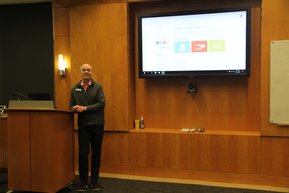Group Videoconferencing from the Classroom
As of March 12, a Zoom Pro license is now available to all faculty, staff, and students at William & Mary while classes are being instructed remotely.
William & Mary began using the videoconferencing technology Zoom in early 2017 when the School of Education launched its fully online Ed.D. program. Program Director Peggie Constantino needed a way to reliably videoconferencing with the online cohort. At her request, W&M IT began testing a variety of options. Client Services Technologist Brandon Corbett recalls that W&M IT had previously been using a suite of different videoconferencing tools, including an equipment-based technology which was reliable, but clunky and difficult for beginners to use. "We had to find a 'do-it-all' product," Corbett says.
Finding a Match
Corbett had attended a couple meetings using a product called Zoom, and had been impressed. However, Technology Spaces Strategist John Drummond took some convincing. "I was resistant to it at first — at the time we had several different platforms in use and wanted to reduce their number," Drummond recalls. But Drummond was soon won over by Zoom. "It works consistently and it’s rare to get a trouble ticket," he says.
The first test was whether the Ed.D. program would find it useful for their needs. "They really tested whether they wanted to use it, and decided they did," Corbett says. A match had been made for the program, but would W&M IT be able to put Zoom to use among the broader campus community?
Corbett and Drummond thought so, and the transition from the previous equipment-based technology to Zoom ultimately took only a few months. All campus users were given access to the basic Zoom license, with a Pro license available on request. W&M IT initially bought a package of 20 Zoom Pro licenses; three years later, there are now more than two hundred. These accounts are tied to the single sign-on service so users only have to remember their W&M Username and password. Drummond says the growth of Zoom on campus has been completely organic. “People see colleagues using it and want to adopt it,” he says. “Success that people have with a technology makes them like that technology.”
 Creating "Zoom Rooms"
Creating "Zoom Rooms"
Basic Zoom licenses come with some limits on meeting duration and group size. This was an initial hurdle to faculty and staff who wanted to use their license to convene remote group meetings. “You can only have a 40-minute meeting if it’s more people than one-on-one,” Drummond explains. Pro licenses allow more flexibility, but Zoom’s business policies restrict sharing licenses among users or getting group accounts.
W&M IT quickly saw the need to implement group videoconferencing in a cost-effective way. The solution? Outfit rooms with a sound and video display so multiple users can gather in one space: a Zoom Room.
“A Zoom Room makes it so anyone can walk in and start a call,” says Drummond. Corbett adds that they are especially important for people trying to have a meeting with several different endpoints. Because the Zoom license is tied to the room and not an individual account, it allows people to initiate a videoconferencing call regardless of whether they have a license. Drummond says the issues he has seen have been mainly administrative rather than technical.
The idea for establishing videoconferencing spaces is not new to William & Mary. The Millennium Classroom in Boswell Hall 343, funded by the class of 1975, has been used for teaching remote classes on campus since 2002. Drummond explains that this room is equipped with a videoconferencing hardware setup that requires an IT technician to facilitate at both ends. The room was recently upgraded to Zoom in early March, and IT staff will no longer need to be regularly involved as the process will be more straightforward and user-friendly. “It’s been the most successful enterprise deployment I’ve ever done in my career,” quips Drummond.
Putting Zoom Rooms to Use
Don Snyder, William & Mary’s Associate Director for STEM Industry Advising, can attest to the convenience of using the Cohen Career Center’s Zoom Room. He links students to alumni networks and opportunities using Zoom to hold panels and group discussions. One such meeting was for undergraduates in the St. Andrews Joint Degree Programme.
“We had students at St. Andrews and William & Mary connecting with each other in real time through Zoom to learn about resources and programs at both institutions,” Snyder recalls. The Career Center has also held remote information sessions with employers in Chicago and New Jersey. “The Zoom Room has been consistent in our usage, including connection and video and audio synchronization,” Snyder says, adding that the software is easy to navigate and to guide participants using it.
Where are Zoom Rooms at William & Mary?
There are currently nine Zoom Rooms on campus (green):
- Swem Library basement:
- Ford Classroom
- Cox Classroom
- Kyle Classroom
- Cohen Career Center first floor presentation room
- Auxiliary Services Corner House office
- Alan B. Miller Hall 2035 in the Raymond A. Mason Business School
- Alan B. Miller Entrepreneurship Center at Tribe Square
- Jones Hall 235 IT conference room
- Millennium Classroom in Boswell Hall 343
W&M IT plans to add two new Zoom Rooms (gold):
- Conference room in the Reves Center for International Studies (in progress, pending hardware configuration and installation)
- In the upcoming Integrated Science Center 4 (ISC4), located adjacent to the west of ISC1 (pending construction)















